Common Terms Used In Ayurveda Herbal Pharmaceutics
Let us learn a few terminologies that are quite commonly used whenever medicines are described. Just for example, the term Triphala is mentioned wherever group of 3 fruits – Haritaki, Vibhitaki and Amla are used, the term Trikatu is used wherever, ginger, pepper and long pepper are used together. Getting a hold of these terminologies will help in understanding Ayurvedic medicines in a better way.

Table of Contents
Paribhasha – Definitions
Paribhasha – definitions help to understand and explore
Avyakta – unexpressed, hidden concepts
Anukta – unspoken, unexplained concepts
Leshokta – less explained concepts
Sandigdha – controversial, difficult-to-understand concepts of the science.
Like a lamp helps to visualize things properly, Paribhasha helps to understand the science properly.
Triphala
Haritaki – Terminalia chebula
Vibhitaki – Terminalia bellirica
Amalaki – Emblica officinalis
Dry fruit rind powders of these three, in equal quantities is called as Triphala.
Synonyms of Triphala Churna – Phalatrika, Vara.
Read more about Triphala Churna benefits
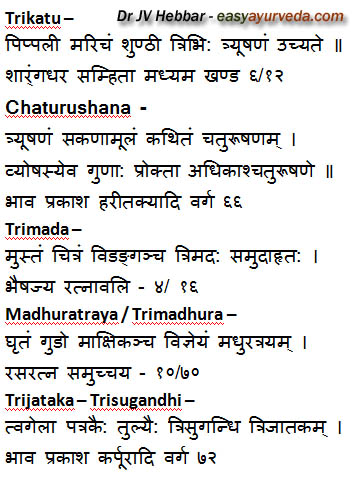
Trikatu Churna
Pippali – long pepper fruit – Piper longum
Maricha – black pepper – Piper nigrum and
Shunti – Ginger – Zingiber officinalis
Are together in equal quantities is called Trikatu or Trayushana.
Read more about Trikatu Churna benefits
Chaturushana
Chatur means four. Ushana means hot or pungent spices.
Trikatu + Pippalimoola (root of Pippali) is called Chaturushana.
They are –
- Pippali – long pepper fruit – Piper longum
- Maricha – black pepper – Piper nigrum and
- Shunti – Ginger – Zingiber officinalis
- Pippalimoola – Root of Long Pepper – Piper longum
The qualities of Chaturushana is quite similar to Trikatu Churna. But it is hotter, stronger and more pungent.
Trimada
Musta – Nut grass – Cyperus rotundus
Chitraka – Leadwort – Plumbago zeylanica
Vidanga – False black pepper – Embelia ribes
Are together called Trimada.
This combination improves digestion, useful in worm infestation.
This combination is found in Navayasa Churna.
Trimadhura or Madhura Traya
Ghrita – ghee
Guda – jaggery
Makshika – honey
Are together called Trimadhura or Madhura traya.
Tri or Traya means three. Madhura means sweet.
Trijata – Trisugandhi
Twak – Cinnamon – Cinnamomum zeylanicum
Ela – Cardamom – Elettaria cardamomum
Patra – Cinnamomum tamala
Are together called Trijata / Trisugandhi
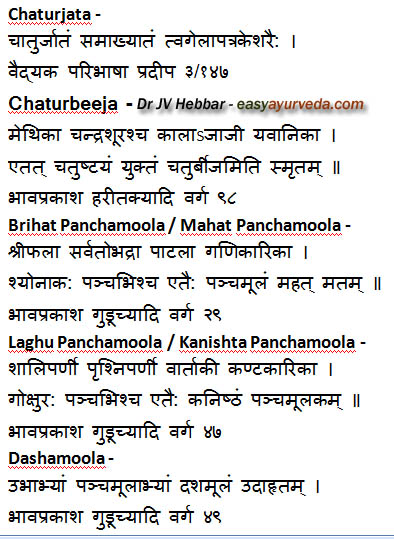
Chaturjata
Twak – Cinnamon – Cinnamomum zeylanicum
Ela – Cardamom – Elettaria cardamomum
Patra – Cinnamomum tamala
Nagakeshara – Mesua ferrea
Are together called Chaturjata. Read more – Chaturjata Benefits
Chaturbeeja
Seeds of
Methika – Fenugreek – Trigonella Foneum Graecum
Chandrashura – Lepidium sativum
Yavanika – Trachyspermum roxburghianum
Ajaji – Cumin seed – Cuminum cyminum
Are together called Chaturbeeja.
Brihat Panchamoola / Mahat Panchamoola
Brihat means big, Pancha means 5, Moola means root. The roots of five big trees are considered here.
Bilva – Bael tree – Aegle marmelos
Agnimantha – Premna mucronata
Shyonaka – Oroxylum indicum
Patala – Stereospermum suaveolens
Gambhari – Gmelina arborea – are called as Brihat Panchamoola.
Laghu Panchamoola / Kanishta Panchamoola
Laghu means small, Pancha means 5, Moola means root. The roots of five small herbs are considered here.
Brihati – Solanum indicum
Kantakari – Solanum xanthocarpum
Gokshura – Tribulus – Tribulus terrestris
Shalaparni – Desmodium gangeticum
Prishniparni – Uraria picta are together known as Laghu Panchamoola
Dashamoola
Brihat and Laghupanchamoola are together called as Dasmoola. It is a very good anti inflammatory combination. Read more – Dashamoola Kashayam
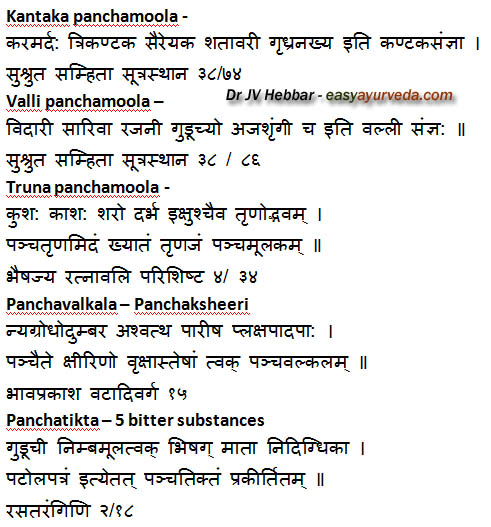
Kantaka panchamoola
Kantaka means thorns. Root of five plants having thorns
Karamarda – Carissa congesta
Gokshura – Tribulus – Tribulus terrestris
Saireyaka – Barleria prionitis
Shatavari – Asparagus – Asparagus racemosus
Grudhranakha – Himsra – Capparis sepiaria
Are together known as Kantakapanchamoola
Valli panchamoola
Valli means climber / creeper. This is the group of roots of five creepers. Though turmeric is not a creeper, it is still included here.
Vidari – Indian kudju – Pueraria tuberosa
Sariva – Indian Sarsaparilla – Hemidesmus indicus
Rajani –Turmeric – Curcuma longa
Guduchi – Indian tinospora – Tinospora cordifolia
Ajashrungi – Karkatashrungi – Pistachia chinensis
Truna panchamoola
Truna means grass. It is a group of five grasses, roots of which have medicinal qualities.
Kusha – Desmostachya bipinnata
Kasha – Saccharum spontaneum
Shara – Saccharum munja
Darbha –Imperata cylindrica
Ikshu – Sugarcanne – Saccharum officinarum
Read more about Truna Panchamoola Kwatha
Panchavalkala – Panchaksheeri
Valkala means bark. This is a group of five barks
Vata – Ficus benghalensis
Udumbara – Ficus glomerata
Ashwattha – Ficus religiosa
Plaksha – Ficus lacor
Parisha – Ficus arnottiana / Thespesia populnea
These have astringent and cleansing property. Hence decoction of this, is used in giving vaginal douche in case of infection and to irrigate wound to cleanse the wounds, to remove debris and heal wounds faster.
Panchatikta – 5 bitter substances
Guduchi – Indian Tinospora stem – Tinospora cordifolia
Nimba – Neem root bark – Azadirachta indica
Bhishag mata – Vasa – Adhatoda vasica
Nidigdhika – Kantakari – Solanum xanthocarpum
Patola – Pointed gourd – Trichosanthes cucumerina
Read more about qualities of Panchatikta Kashaya (water decoction)
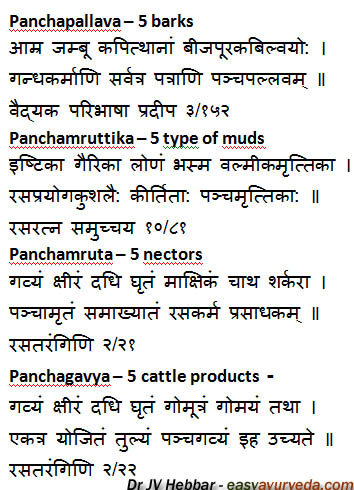
Panchapallava
Pallava – fresh shoots / leaves
Amra – Mango bark – Mangifera indica
Jambu – Jamun bark – Eugenia jambolana
Kapittha – Feronia limonia / Limonia acidissima
Beejapura – Citrus medica
Bilva – Bael tree bark – Aegle marmelos
Panchamruttika – 5 type of muds
Ishtika – mud from which tiles can be made
Gairika – Red ochre – Iron oxide
Lona – Saindhava Lavana
Bhasma – ash of herbs
Mruttika – Bambi mitti / Deemak ki mitti.
Panchamruta – 5 nectars
Goksheera – cow milk
Go dadhi – cow curds
Go Ghrita – ghee
Makshika – honey
Sharkara – sugar
This is also used in Hindu spiritual rituals.
Panchagavya – 5 cattle products
Goksheera – cow milk
Go dadhi – cow curds
Go ghrita – cow ghee
Go mutra – cow urine
Gomaya – cow dung
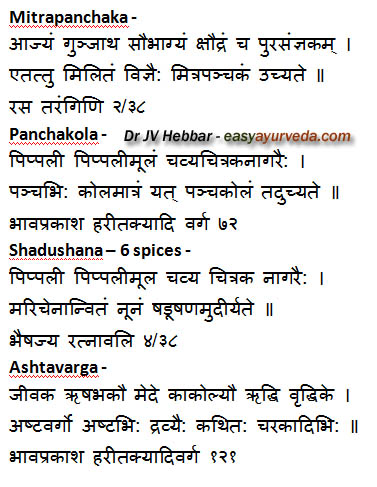
Read more about herbal ghee prepared out of this, called Panchagavya Ghrita
Mitra Panchaka
Ajya – cow ghee
Gunja – Abrus precatorius
Saubhagya – Tankana – Borax
Kshaudra – honey
Pura – Guggulu – Commiphora mukul
Dravaka Gana
Mitrapanchaka plus Guda (jaggery)
Mitra Panchaka and Dravaka Gana are usually used in making Bhasma of metals and minerals. They help to melt the metal faster, at a lower temperature. Drava means liquid. Hence the name Dravaka gana. Once after melting the metal, these substances like jaggery, guggulu etc help to retain the higher temperature for a longer period of time, while making Bhasma.
Panchakola
Pippali – Long pepper fruit – Piper longum
Pippalimoola – Long pepper root
Chavya – Piper cubeba
Chitraka – Leadwort – Plumbago zeylanica
Nagara – ginger rhizome – Zingiber officinale
Each one is taken in 1 kola (6 grams) quantity. Hence the name Panchakola.
Shadushana – 6 spices
Shat means six. Ushana means spices.
They are –
Pippali – Long pepper fruit – Piper longum
Pippalimoola – Long pepper root
Chavya – Piper cubeba
Chitraka – Leadwort – Plumbago zeylanica
Nagara – ginger rhizome – Zingiber officinale
Maricha – Black pepper – Piper nigrum
Ashtavarga
Jeevaka – Malaxis acuminata
Rishabhaka – Manilkara hexandra
Meda – Polygonatum cirrhifolium
Mahameda – Polygonatum verticillatum
Kakoli – Fritillaria roylei
Kshira Kakoli – Roscoea purpurea
Vruddhi – Habenaria intermedia
Ruddhi – Habenaria intermedia
Ashtavarga is made famous by certain companies, since it is used in preparing Chyawanprash.
Jeevaneeya gana
Jeevaneeya means enlivening, which is anti ageing, which improves life expectancy.
As per Bhavaprakasha –
Ashtavarga plus
Mudgaparni – Phaseolus trilobus,
Mashaparni – Teramnus labialis
Yashtimadhu – Licorice,
Jivanti – Leptadenia reticulata.
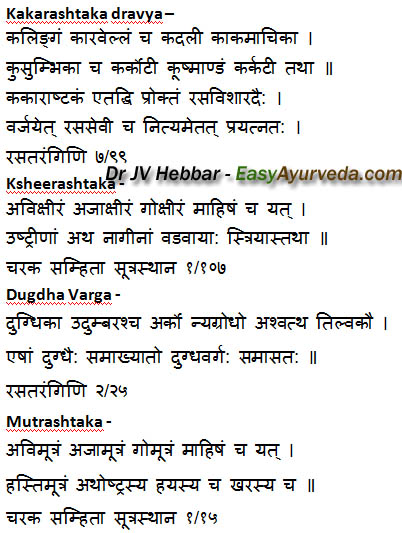
Kakara Ashtaka Dravya
These are 8 herbs having ‘ka’ as their first letter.
Kalinga – conessi bark / tellicherry bark / kurchi – Holarrhena antidysenterica
Karavellaka – Bittergourd – Momordica charantia
Kadali – Banana – Musa paradisiaca
Kakamachi – Solanum nigrum
Kusumbhika – Safflower – Carthamus tinctorius
Karkoti – Ribbed gourd – Luffa acutangulata
Karkati – Cucumis utilissimus
Kushmanda – white pumpkin / Ash gourd – Benincasa hispida
When purified and processed Mercury is given for anti ageing and rejuvenation purpose, the consumption of these herbs should be avoided.
Ksheera Ashtaka
Group of 8 milks –
Aviksheera – sheep milk
Ajaksheera – goat milk
Goksheera – cow milk
Mahisha ksheera – buffalo milk
Ushtraksheera – camel milk
Hasthi ksheera – elephant milk
Ashwa ksheera – horse milk
Manusha ksheera – human milk
Dugdha Varga
Group of herbs having latex.
Dugdhika
Udumbara
Arka
Vata
Ashvattha
Tilvaka
Mootra Ashtaka
Group of 8 urines –
Avimutra – sheep urine
Ajamutra – goat urine
Gomutra – cow urine
Mahisha Mutra – Buffalo urine
Hasti Mutra – elephant urine
Ushtra Mutra – camel urine
Haya Mutra – horse urine
Khara Mutra – donkey urine
Kshara (alkali)
Kshara is obtained by ash of herbs. They are strong and pungent and used in digestive disorders, Ksharasutra therapy for fistula etc.
Kshara – yavakshara
Ksharadvaya – Yavakshara, swarjika kshara
Ksharatraya – Yava, swarjika tankana.
Ksharapanchaka – yava, swarjika, palasha, tilakshara mushkaka,
Ksharashtaka – yava, swarjika, palasha, tila, apamarga, snuhi, chincha, arka
Lavana (salts)
Lavana traya –
Three salts
Saindhava, Sauvarchala (ruchaka) and Vida Lavana
Lavana panchaka –
Saindhava, Sauvarchala (ruchaka), Vida, Samudra, Audbhida (romaka)
Lavana Shashtaka .
Saindhava, Sauvarchala (ruchaka), Vida, Samudra, Audbhida (romaka)
Chullika lavana.
Lavana Shashtaka –
Samudra Lavana
Saindhava
Bida Lavana
Sauvarchala Lavana
Romaka Lavana
Chullika Lavana
Read more about types of salts
Vishavarga
Group of poisonous herbs used in treatment –
Vatsanabha – Aconitum ferox
Haaridra saktuka, Pradeepana, Saurashtrika, Shrungika, Kalakuta, Halahala, Brahmaputra – bhavaprakaasha dhaatvadi varga
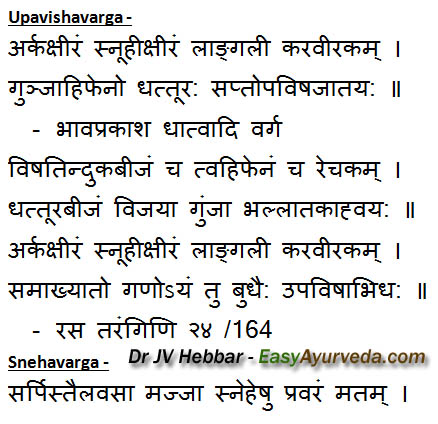
Upavisha Varga
Group of less poisonous herbs used in therapeutics
Vishatinduka – Strychnos nux vomica
Ahiphena – Papaver somniferum
Rechaka – Jayapala – Croton tiglium
Dhattura Beeja – Datura metel
Vijaya – Cannabis sativa
Gunja – Abrus precatorius
Bhallataka – Semecarpus anacardium
Arka Ksheera – Latex of Calotropis procera
Snuhi Ksheera – Latex of Euphorbia nerifolia
Langali – Gloriosa superba Linn.)
Karaveera – Thevetia neriifolia
Snehavarga
Group of fats
Sarpi – Ghee
Taila – Sesame oil
Vasa – Fat of animals
Majja – Bone marrow of animals
Amla Varga
Group of sour herbs –
Jambira
Bijapuraka
Matulunga
Changeri
Chanakamla
Amlika
Kola
Dadima – Pomegranate
Ambashta
Tintidika
Naranga
Rasapatrika (Chukrika)
Karavanda
Amlapanchaka
Five sour substances –
Amlavetasa
Jambeera
Matulunga
Naranga
Nimbuka
Treatment for alcoholic disorder with high Pitta – Pittaja Madatyaya Cikitsa
कोलदाडिमवृक्षाम्लचुक्रीकाचुक्रिकारसः ।
पञ्चाम्लको मुखालेपः सद्यस्तृष्णां नियच्छति ॥ ३१ ॥
koladāḍimavṛkṣāmlacukrīkācukrikārasaḥ |
pañcāmlako mukhālepaḥ sadyastṛṣṇāṃ niyacchati || 31 || Ashtanga Hrudaya Chikitsa Sthana 7/31
Fresh juice of the – Panchamla – five sours viz,
kola – Ziziphus mauritiana,
dāḍima – Punica granatum,
vṛkṣāmla – Garcinia indica,
cukrīkā – Rumex vesicarius
cukrikā – and Oxalis corniculata
smeared inside the mouth relieves the thirst immediately.
Taila varga
Group of herbs that yield oil
Jyotishmati – Celastrus paniculata
Atasi – Linseed
Nimbataila – Neem oil
Tila – sesame
Apamarga – Achyranthes aspera
Siddhartha – Mustard
Somaraji
Vibhitaki Taila – Terminalia bellirica
Bakuchi – Psoralea corylifolia
Bhallataka Taila – Semecarpus anacardium
Narikelataila – coconut oil
Gandhavarga – Sarvagandha
Group of fragrant herbs
Chaturjata, Karpura, Kamkola, Agaru, Shilajatu, Lavanga










10 comments
Shaila Kamble
THANK YOU FOR SUCH
NICE EXPLANATION.
Dr J V Hebbar MD(Ayu)Author
Welcome!
ruby
Sir impressive..easy to learn and understand..thanku…i hav taken screenshot f all dis and vl keep ds in ma phone.godbless u.jai dhanvantari.
Sharon Feldman
Please what is the name products of bhallataka taila and Bhallataka ksheera 101
Sharon Feldman
Maybe i not searching well. I am looking for Bhallataka oil
Pure oil of bhallataka. And Bhallataka ksheera 101 and Bhallataka TAILAM or Bhallataka taila… What the name of this products? Maybe they anther names because i not find that. Thanks again
Dr J V Hebbar MD(Ayu)Author
The names are same as you have mentioned. But I do not know of any manufacturer of the said products.
Raghavendra
Hi Sir,which company chaturushna is best to use?